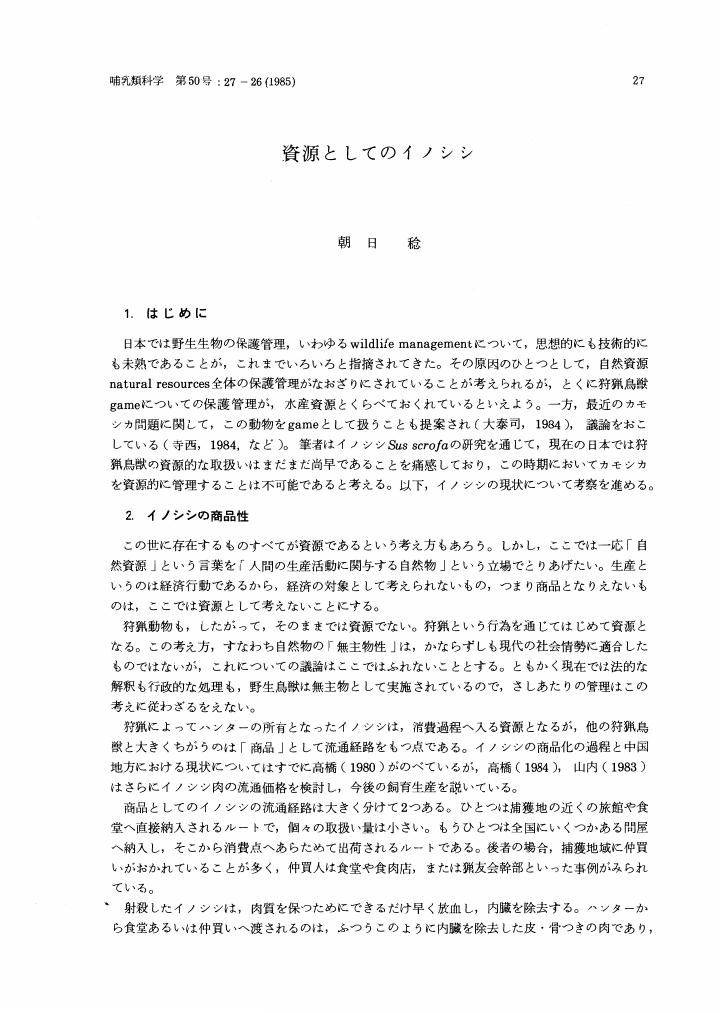1 0 0 0 IR タヌキの歯数異常
Deficiencies and surplus eruptions in the teeth of raccoon-dogs were examined using 340 specimens collected mainly from three localities in western Japan. Abnormalities in the dentition occurred in 26% of 308 perfect skulls. On the upper jaw, 9 examples of pm-1 deficiencies on both sides occurred, 8 on left side alone and 4 on right side alone among 317 specimens. There were no significant differences between the sexes, but differences did exist among localities. There were i-1, i-2, i-3, pm-2 and m-2 deficiencies, and i-surplus eruptions in some specimens. On the lower jaw, m-3 deficiencies occurred more frequently. Incidences of deficiencies on both sides, left and right side alone were 19, 19 and 15 respectively among 314 specimens. No significant difference was found between sexes and among localities. Other deficiencies were observed on i, pm-1, pm-2, pm-3 and pm-4. One surplus eruption occurred between c and pm-1. In one specimen, pm-4 duplications in the buccolingual direction were observed on both sides.
1 0 0 0 OA 資源としてのイノシシ
- 著者
- 朝日 稔
- 出版者
- 日本哺乳類学会
- 雑誌
- 哺乳類科学 (ISSN:0385437X)
- 巻号頁・発行日
- vol.25, no.1, pp.1_27-30, 1985 (Released:2008-10-01)
1 0 0 0 OA 飼い鳥の種間順位関係と高さによるすみわけ
- 著者
- 朝日 稔
- 出版者
- 日本生態学会
- 雑誌
- 日本生態学会誌 (ISSN:00215007)
- 巻号頁・発行日
- vol.7, no.1, pp.39-42, 1957-05-31
1. The cage used in the present study is a rectangular parallelopiped from, about 250cm×90cm at the base, and 850cm in height. 11 perches of tree branches are set in the cage, and the cage is divided into 9 sections (Fig.1). The names and numbers of the birds are shown in Table 1. Observations were made from Sept.27 to Oct.27,1956,in two periods separated by the transpositions of perches on Oct.10. 2. Interspecific antagonism is found in peckings and avnidances. Their frequencies are shown in Tables 2 and 3,which suggest the existence of the linear dominance-order among species. 3. The vertical distribution of each species observed in the cage is summarized in Fig.2. Apparently the individuals of Psittaciformes are found in the upper region of the cage (Sect.5-Sect.9), the individuals of Columbiformes in the lower (Sect.1), and the individuals of Passerlfomes in the middle. This segregation is probably derived from the differences of the life-forms of each Order. In the same Order, there are two types of interspecific distributions : the separating type, for example, Psittacus eyanocephala and Melopsittacus undulatus observed in the latter period, and the overlapping type, for example, Agapornis roseicollis and A. lilianae. Further observations reveal that the individuais of each species make species-flocks even in the overlapping type and they often exchange the perches (see Fig.3.) The principle of "habitat-segregation", proposed by K.IMANISHI (1941), is thus realized at all times. Only Taeniopygia castanotis and Uroloncha striata often make hetero-specific flocks together.

